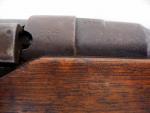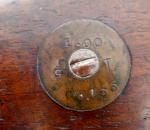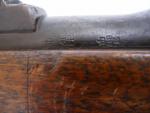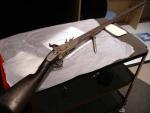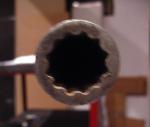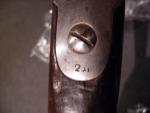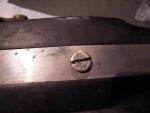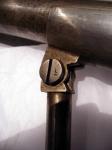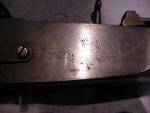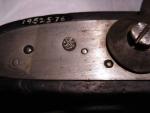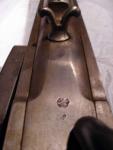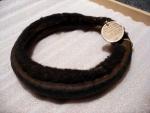
helen
For Deletion-
Posts
166 -
Joined
-
Last visited
Content Type
Profiles
Forums
Blogs
Gallery
Events
Store
Everything posted by helen
-
Thank you all for your helpful responses as ever, especially Chris and Peter. I had heard of the term 'rolling fire' before too, but had never really considered what it meant. Some interesting bits of history here, especially to see how the attempts to maintain as constant a stream of fire as possible had to be considered amid the practicalities of slower shooters, smoke clearing, and pans flashing in your comrade's faces!
-
I've read that the Protestant armies (notably Sweden) introduced salvo fire in the Thirty Years War in the 17th century and that not long after, the development of the flintlock brought about volley fire, which was adopted across Europe by the end of the 18th century. I understand that salvo was meant to permit a constant stream of fire by two or more ranks whilst the rest reloaded, but how is this different to volley fire? Is it something to do with combining fire with pike charges etc? If anyone can elaborate on the tactical differences between salvo and volley, it would be much appreciated! With thanks, Helen Image: Battle of White Mountain, 1620
-
New british P1892/95 infantry officer's sword
helen replied to Jonathan Hopkins's topic in Swords & Edged Weapons
Lovely piece! A slice of the old world approaching the new at the fin de siecle. -
Nice pistols, thanks for showing them! They are what's known as 'boxlock' is that right? I guess these would be 1840s? The moulding of the nipple on the top doesn't look like a conversion from a turn-off flintlock (as many percussion turn-off pistols of the 1820s/30s were, I believe) but I don't think that distinctive handle and butt shape continued much after 1850.
-
I see, yes of course that makes sense, otherwise I guess you'd be trying to implant a mine while it's armed! Thanks.
-
Yes, and an innovative one at that. He came up with a brand new design for the museum, and for its relocation, in the 1960s, rather along the lines of Pitt Rivers' original 'segmented concentric circle' layout. The architect was Pier Luigi Nervi (the chap who built the Olympic Stadium in Rome) but the cash for it could not be raised and the stress of it all resulted in Fagg having a stroke. This piece was not identified until 10 years after his death as having possibly belonged to him... Yes, could be mine fuse, but why would it have a pin that you evidently remove manually? Wouldn't a mine just have a pressure-sensitive firing mechanism/detonator?
-
Just read that the object's donor was probably one Bernard Fagg, an archaeologist who served in the 1st Field Company WAE (West African Engineers) during WW2 if that is any help....
-
Hello everyone, Haven't posted for a while. I was wondering if anyone could help me identify what kind of grenade this top part would have come from. As you can see, the pin is still intact but it has somehow become detached from the main body (whereabouts not known). Maybe picked up on battlefield. The only info we have about it is that it is probably European and first half of C20th. Any help - what kind of grenade, how old, where from, etc - would be gladly appreciated. Thanks, Helen
-
hi Brian, Lovely pistols. Curious rear extension to the handle and would certainly be interesting to know the maker - perhaps the museum has an online search facility to find out more? Most duelling pistols were between 0.45 and 0.65 calibre. Whilst it was 'frowned upon' in Europe really from the C18th, duels still occurred often as a formality. There was a famous one between Wellington and Lord Winchelsea in 1829 so not that far off the date of yours. Although both were more fortunate than poor Mr. Lyons - Wellington deliberately missed and Winchelsea fired into the atmosphere. I hope Mr Wilson and Miss Elizabeth lived happily ever after...?!
-
Mervyn, Apologies for not posting for a while. Re - the headrings paper...I think the idea is worth pursuing but it would need more initial research to secure a strong enough line of argument. I have found a few references to 'isicoco' in book and papers but mostly only explaining what they are, that they are removed in widowhood as a sign of mourning, and that as far back as 1924, one author considered the wearing of such headrings 'almost extinct and found only among old men' (Braunholtz in MAN, 1924). Have you seen the head-ring as a 'detachable hat/wig' anywhere else apart from the images I posted? Wouldn't the way the ring was originally formed on the man's head, being effectively stuck to his scalp with insect secretion/gum, mean that the ring would stay put anyway, even if the hair follicle died and fell out? It seems, from studying figurative sculpture alone, that the old 'rebel' Zulu tribes (the Swazi, Shangaan (Tsonga) and Ndebele) also all retained the headring as a symbol of male status. I found this sculpture on display in the Museum, again showing off the headring. Apologies for the poor quality photograph - it is behind glass! It has a fairly interesting story behind it: it was part of a collection of carved woodwork, beadwork and shell jewellery given by an old hunter as a wedding present to Kate Theresa Escombe, daughter of the Rt. Hon. Harry Escombe who was Premier of Natal in 1897. She married Sidney Francis Gedge in 1888 and settled in England. He died when their two children were still little boys. In 1900 she married the Rev. Henry Tower (later Canon of Christchurch, Oxford). The collection was presented to the Museum by Cicely and Meriel Tower, the two daughters of her second marriage, in 1987. According to the Afri-Karner Museum Trust in Franschhoek, South Africa, they hold a similar piece, as does the Killie Campbell Collection in Durban. It will be interesting to see if the Museum at Ulundi get back to you... Helen
-
Mervyn, Apologies for not posting for a while. Re - the headrings paper...I think the idea is worth pursuing but it would need more initial research to secure a strong enough line of argument. I have found a few references to 'isicoco' in book and papers but mostly only explaining what they are, that they are removed in widowhood as a sign of mourning, and that as far back as 1924, the author of one such paper considered the wearing of such headrings 'almost extinct and found only among old men'. Have you seen the head-ring as a 'detachable hat/wig' anywhere else apart from the images I posted? Wouldn't the way the ring was originally formed on the man's head, being effectively stuck to his scalp with insect secretion/gum, mean that the ring would stay put anyway, even if the hair follicle died and fell out? It seems, from studying figurative sculpture alone, that the old 'rebel' Zulu tribes (the Swazi, Shangaan (Tsonga) and Ndebele) also all retained the headring as a symbol of male status. I found this sculpture on display in the Museum, again showing off the headring. Apologies for the poor quality photograph - it is behind glass! It has a fairly interesting story behind it: it was part of a collection of carved woodwork, beadwork and shell jewellery given by an old hunter as a wedding present to Kate Theresa Escombe, daughter of the Rt. Hon. Harry Escombe who was Premier of Natal in 1897. She married Sidney Francis Gedge in 1888 and settled in England. He died when their two children were still little boys. In 1900 she married the Rev. Henry Tower (later Canon of Christchurch, Oxford). The collection was presented to the Museum by Cicely and Meriel Tower, the two daughters of her second marriage, in 1987. According to the Afri-Karner Museum Trust in Franschhoek, South Africa, they hold a similar piece, as does the Killie Campbell Collection in Durban. It will be interesting to see if the Museum at Ulundi get back to you...\ Helen
-
Yes, the wooden undercarriage beneath the barrel has been intentionally shortened, there is evidence of chisel marks - I will take and post a photo when I get a chance. Although presumably a carbine model is already pretty short and wieldy so not sure why they needed to lighten it any more. As for the story of this weapon, a member of the gunboard forum got back to me to say that the mark on the button on the bolt suggests issue to the 9th Queens Royal Lancers who played a big part in the relief of Kimberley and various other episodes in Cape Colony in 1899-1900. The information with this gun claims it was captured from the Boers in 1902, so presumably this was a 'recapture', perhaps a year or two after the Boers got their hands on it from the battlefield in one of these earlier engagements, and modified it. As for Judge Hugo, I couldn't find many refences apart from this one from Conan Doyle's account of the Boer War: "The re-establishment of settled law and order was becoming more marked every week in those south-western districts, which had long been most disturbed. Colonel Crewe in this region, and Colonel Lukin upon the other side of the line, acting entirely with Colonial troops, were pushing back the rebels, and holding, by a well-devised system of district defence, all that they had gained. By the end of February there were none of the enemy south of the Beaufort West and Clanwilliam line. These results were not obtained without much hard marching and a little hard fighting. Small columns under Crabbe, Capper, Wyndham, Nickall, and Lund, were continually on the move, with little to show for it save an ever-widening area of settled country in their rear. In a skirmish on February 20th Judge Hugo, a well-known Boer leader, was killed, and Vanheerden, a notorious rebel, was captured. At the end of this month Fouche's tranquil occupation of the north-east was at last disturbed, and he was driven out of it into the midlands, where he took refuge with the remains of his commando in the Camdeboo Mountains. Malan's men had already sought shelter in the same natural fortress. Malan was wounded and taken in a skirmish near Somerset East a few days before the general Boer surrender." Source: http://en.wikisource.org/wiki/The_Gr...War/Chapter_35 Apparently it was not unusual for the Boers to personalise their rifles as, once issued, they were theirs. So presumably the 'DVH' are the Judge's initials but no idea what the D and V stand for...I looked up the Dutch for 'judge' and it didn't fit!
-
H.M.S. VICTORY - SCALE MODEL
helen replied to Mervyn Mitton's topic in Great Britain: Militaria: Badges, Uniforms & Equipment
Fascinating! I will have to look out for those lanterns next time I'm in London... Helen -
Hello, Just wanted to show some pics of this Enfield and see whether you have any comments or thoughts about it, or can tell me anything through the marks. It has been chopped around a bit during its capture by (and subsequent recapture from!) the Boers. Here is the information on the card that came with it to the museum where it now lives: 'Enfield 1898, .303 rifle, found by the donor's brother, Frederick Nicholas Griffin, after an engagement with the BOERS at WAGENAARS KRAAL, CAPE COLONY, 18 Feb. 1902. The wooden encasement beneath the barrel has been cut away, presumably to lessen the weight as a whole. The firing-pin has been filed away at the point. Its owner Judge HUGO was killed during the action. Length 3' 4".' Is this weapon the same as the MLE or 'Long Lee' that was issued in 1895? Thanks
-
I know, that confused me a bit too! Although I've seen mention of a French rifled wall-gun, issued in 1840 (see H. Coburn, United Service Magazine, 1852, p.420). It may altogether may be some sort of hybrid, or at least, an adapted or 'mongrel' weapon. As far I can see there are no more numbers to be seen on it, so perhaps the mystery may never be fully solved!
-
More detailed photos. I may have made a mistake in my previous assertions that the mark was repeated on the barrel. In fact, the barrel has not markings at all, just the lock plate, butt plate and other attachments (screws, etc). The muzzle mouth measures 3.2 cm (1 & 1/4 inch) in total (including edges of barrel), whilst the actual hole (bore size) is 2cm (7/8 inch). The gun weighs 10.6 kg (just over 23 lbs). Helen
-
hi Tom, Mervyn will probably know more about the spear but the dagger is of the 'ikul' type of the Kuba (Bushong) people, (pre-colonial state in what is now DR Congo). See here: PRM Ikul I believe it is more a status/identity symbol than a functional weapon. Helen
-
Peter - yes, that's true - we have a number of American items (such as a Northern Plains gunstock club) decorated with brass, trade 'furniture tacks' (although they are a bit shinier than on this powder horn!). I suppose they could just have easily made it to Africa...? Here is a picture. Helen P.S. This club (red on the opposite side) is one of my favourite objects in the museum!
-
Old label: 'INDUNA'S HEAD RING, CUT FROM THE WEARER'S HEAD, WITH THE HAIR REMAINING ATTACHED. KAFFIR [sic], NATAL'
-
Mervyn - thanks for taking the time to add these wonderful comments and insights - they will add greatly to our documented knowledge about some of these items....as you say the label info on some of them is pretty vague and sometimes just plain wrong! I will reply under each object's remarks, and sometimes provide a little more contextual information where I have it as it will help confirm or anticipate some of Mervyn's observations. Today I only have time to tackle the first 4 but will get round to the rest later this week! This is literally a toe-dip in the pool of the 500+ Zulu items we have. Unfortunately, our storage for the museum is only suitable for smaller objects...anything bigger than hand-size is kept off-site and often are not photographed. However, I will add more as and when I can. Helen 1 Brass anklet - this could also be an upper arm band - one has to measure. The date is prior to 1879 - we destroyed all the brass castings. Yes, the date '1884' on the label means this was formed part of Pitt Rivers original collection of around 20,000 items, given to found the museum in 1884. The notes say it was obtained by WA Fox Pitt (same family) of the 92nd Highlanders. This must be prior to 1881 then as this was when, I believe, the 92nd and the 75th combined to become the Gordon Highlanders. It measures 10cm in diameter. 2 Ivory - or, bone, comb. From the dull look prob. bone. Hand carved they were greatly prized. We've got 'man's comb of horn'. Maybe the dullness is just a result of my photography skill! Collected in 1897. A little note attached says 'late matron, Berea Hospital, Durban, SA'. Quick search on google didn't reveal much about any such place. 2 MAAS spoon. This is like a curdled yoghourt and very popular and nutritious. As used to be with Welsh bridegrooms these were often carved by the young man as a gift to his bride. The conical top represents a penis. One for an un-married girl will often have the shaft as two pieces. Spot on, although I didn't know about the anthropomorphic representation! We've had it down as 'porridge stirrer, known as ukezo'. Collected by Antoinette Powell-Cotton from the Hluhluwe Reserve in 1935. The two Powell-Cotton sisters collected over 5000 Zulu objects, almost half of which they gave to the British Museum. 3 .577 Martini bullets. These have been fired and were probably picked-up from one of the battle sites. Conical one has been filed down and the round ones are musket balls fired from old 'trade' muskets - sold to the Zulus by European dealers. (Think of Native-Americans in the 1860's.) Yes, they were apparently from the battlefield of Kambula, 1879, part of the collection of General William Knox Leet. They came with a 'Zulu Kaffir headring' bound with plant fibre string and covered in parts with a black resin. I attach a photo of this in the next post, together with pictures of two other similar headrings, one believed to be Zulu, one Swazi. Zulu headring collected by Knox, on or before 1879 old label: 'CHIEF'S HEAD-RING, PREPARED AND READY FOR WEARING. BELONGED TO THE SWAZI CHIEF Imbandene'.






